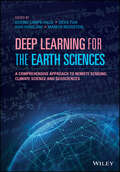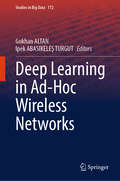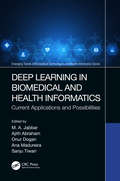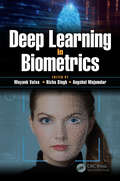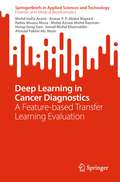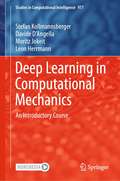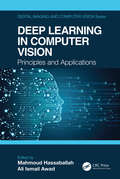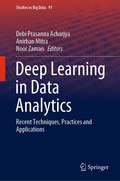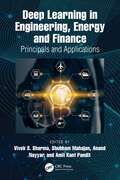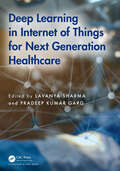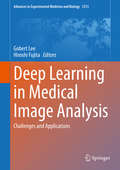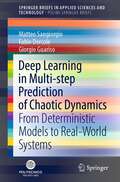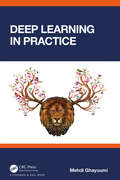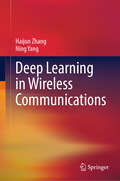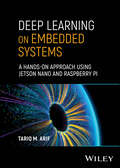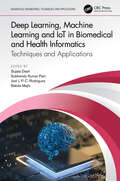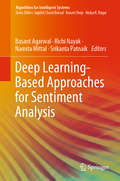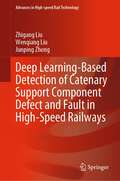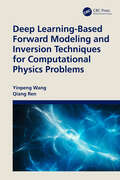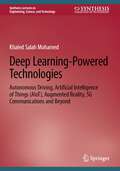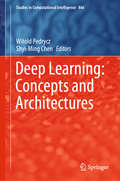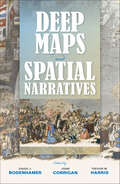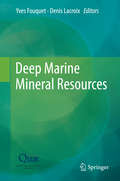- Table View
- List View
Deep Learning for the Earth Sciences: A Comprehensive Approach to Remote Sensing, Climate Science and Geosciences
by Gustau Camps-VallsDEEP LEARNING FOR THE EARTH SCIENCES Explore this insightful treatment of deep learning in the field of earth sciences, from four leading voices Deep learning is a fundamental technique in modern Artificial Intelligence and is being applied to disciplines across the scientific spectrum; earth science is no exception. Yet, the link between deep learning and Earth sciences has only recently entered academic curricula and thus has not yet proliferated. Deep Learning for the Earth Sciences delivers a unique perspective and treatment of the concepts, skills, and practices necessary to quickly become familiar with the application of deep learning techniques to the Earth sciences. The book prepares readers to be ready to use the technologies and principles described in their own research. The distinguished editors have also included resources that explain and provide new ideas and recommendations for new research especially useful to those involved in advanced research education or those seeking PhD thesis orientations. Readers will also benefit from the inclusion of: An introduction to deep learning for classification purposes, including advances in image segmentation and encoding priors, anomaly detection and target detection, and domain adaptationAn exploration of learning representations and unsupervised deep learning, including deep learning image fusion, image retrieval, and matching and co-registrationPractical discussions of regression, fitting, parameter retrieval, forecasting and interpolationAn examination of physics-aware deep learning models, including emulation of complex codes and model parametrizations Perfect for PhD students and researchers in the fields of geosciences, image processing, remote sensing, electrical engineering and computer science, and machine learning, Deep Learning for the Earth Sciences will also earn a place in the libraries of machine learning and pattern recognition researchers, engineers, and scientists.
Deep Learning in Ad-Hoc Wireless Networks (Studies in Big Data #172)
by Gokhan Altan Ipek Abasikeleş TurgutThis book presents innovative applications of deep learning techniques in wireless ad-hoc networks, addressing critical challenges such as trust, routing, traffic management, and intrusion detection. By combining advanced AI models with real-world network scenarios, the chapters explore novel solutions for improving network reliability, security, and efficiency. Readers benefit from a multidisciplinary approach that bridges deep learning and wireless communication, offering both theoretical insights and practical frameworks. Targeting researchers, engineers, and graduate students, this work serves as a valuable resource for understanding and implementing deep learning strategies to optimize modern wireless systems. Whether improving IoT networks, securing controller area networks, or enabling smart mobility, the book provides actionable knowledge on Deep Learning applications for solving current and future challenges in ad-hoc wireless networks.
Deep Learning in Biomedical and Health Informatics: Current Applications and Possibilities (Emerging Trends in Biomedical Technologies and Health informatics)
by Ajith Abraham Ana Madureira M. A. Jabbar Sanju Tiwari Onur DoganThis book provides a proficient guide on the relationship between Artificial Intelligence (AI) and healthcare and how AI is changing all aspects of the healthcare industry. It also covers how deep learning will help in diagnosis and the prediction of disease spread. The editors present a comprehensive review of research applying deep learning in health informatics in the fields of medical imaging, electronic health records, genomics, and sensing, and highlights various challenges in applying deep learning in health care. This book also includes applications and case studies across all areas of AI in healthcare data. The editors also aim to provide new theories, techniques, developments, and applications of deep learning, and to solve emerging problems in healthcare and other domains. This book is intended for computer scientists, biomedical engineers, and healthcare professionals researching and developing deep learning techniques. In short, the volume : Discusses the relationship between AI and healthcare, and how AI is changing the health care industry. Considers uses of deep learning in diagnosis and prediction of disease spread. Presents a comprehensive review of research applying deep learning in health informatics across multiple fields. Highlights challenges in applying deep learning in the field. Promotes research in ddeep llearning application in understanding the biomedical process. Dr.. M.A. Jabbar is a professor and Head of the Department AI&ML, Vardhaman College of Engineering, Hyderabad, Telangana, India. Prof. (Dr.) Ajith Abraham is the Director of Machine Intelligence Research Labs (MIR Labs), Auburn, Washington, USA. Dr.. Onur Dogan is an assistant professor at İzmir Bakırçay University, Turkey. Prof. Dr. Ana Madureira is the Director of The Interdisciplinary Studies Research Center at Instituto Superior de Engenharia do Porto (ISEP), Portugal. Dr.. Sanju Tiwari is a senior researcher at Universidad Autonoma de Tamaulipas, Mexico.
Deep Learning in Biometrics
by Richa Singh Mayank Vatsa Angshul MajumdarDeep Learning is now synonymous with applied machine learning. Many technology giants (e.g. Google, Microsoft, Apple, IBM) as well as start-ups are focusing on deep learning-based techniques for data analytics and artificial intelligence. This technology applies quite strongly to biometrics. This book covers topics in deep learning, namely convolutional neural networks, deep belief network and stacked autoencoders. The focus is also on the application of these techniques to various biometric modalities: face, iris, palmprint, and fingerprints, while examining the future trends in deep learning and biometric research. Contains chapters written by authors who are leading researchers in biometrics. Presents a comprehensive overview on the internal mechanisms of deep learning. Discusses the latest developments in biometric research. Examines future trends in deep learning and biometric research. Provides extensive references at the end of each chapter to enhance further study.
Deep Learning in Cancer Diagnostics: A Feature-based Transfer Learning Evaluation (SpringerBriefs in Applied Sciences and Technology)
by Anwar P. P. Abdul Majeed Mohd Azraai Mohd Razman Rabiu Muazu Musa Ahmad Fakhri Ab. Nasir Mohd Hafiz Arzmi Hong-Seng Gan Ismail Mohd KhairuddinCancer is the leading cause of mortality in most, if not all, countries around the globe. It is worth noting that the World Health Organisation (WHO) in 2019 estimated that cancer is the primary or secondary leading cause of death in 112 of 183 countries for individuals less than 70 years old, which is alarming. In addition, cancer affects socioeconomic development as well. The diagnostics of cancer are often carried out by medical experts through medical imaging; nevertheless, it is not without misdiagnosis owing to a myriad of reasons. With the advancement of technology and computing power, the use of state-of-the-art computational methods for the accurate diagnosis of cancer is no longer far-fetched. In this brief, the diagnosis of four types of common cancers, i.e., breast, lung, oral and skin, are evaluated with different state-of-the-art feature-based transfer learning models. It is expected that the findings in this book are insightful to various stakeholders in the diagnosis of cancer.
Deep Learning in Computational Mechanics: An Introductory Course (Studies in Computational Intelligence #977)
by Stefan Kollmannsberger Moritz Jokeit Leon Herrmann Davide D'AngellaThis book provides a first course on deep learning in computational mechanics. The book starts with a short introduction to machine learning’s fundamental concepts before neural networks are explained thoroughly. It then provides an overview of current topics in physics and engineering, setting the stage for the book’s main topics: physics-informed neural networks and the deep energy method.The idea of the book is to provide the basic concepts in a mathematically sound manner and yet to stay as simple as possible. To achieve this goal, mostly one-dimensional examples are investigated, such as approximating functions by neural networks or the simulation of the temperature’s evolution in a one-dimensional bar.Each chapter contains examples and exercises which are either solved analytically or in PyTorch, an open-source machine learning framework for python.
Deep Learning in Computer Vision: Principles and Applications (Digital Imaging and Computer Vision)
by Ali Ismail Awad Mahmoud HassaballahDeep learning algorithms have brought a revolution to the computer vision community by introducing non-traditional and efficient solutions to several image-related problems that had long remained unsolved or partially addressed. This book presents a collection of eleven chapters where each individual chapter explains the deep learning principles of a specific topic, introduces reviews of up-to-date techniques, and presents research findings to the computer vision community. The book covers a broad scope of topics in deep learning concepts and applications such as accelerating the convolutional neural network inference on field-programmable gate arrays, fire detection in surveillance applications, face recognition, action and activity recognition, semantic segmentation for autonomous driving, aerial imagery registration, robot vision, tumor detection, and skin lesion segmentation as well as skin melanoma classification. The content of this book has been organized such that each chapter can be read independently from the others. The book is a valuable companion for researchers, for postgraduate and possibly senior undergraduate students who are taking an advanced course in related topics, and for those who are interested in deep learning with applications in computer vision, image processing, and pattern recognition.
Deep Learning in Data Analytics: Recent Techniques, Practices and Applications (Studies in Big Data #91)
by Noor Zaman Debi Prasanna Acharjya Anirban MitraThis book comprises theoretical foundations to deep learning, machine learning and computing system, deep learning algorithms, and various deep learning applications. The book discusses significant issues relating to deep learning in data analytics. Further in-depth reading can be done from the detailed bibliography presented at the end of each chapter. Besides, this book's material includes concepts, algorithms, figures, graphs, and tables in guiding researchers through deep learning in data science and its applications for society.Deep learning approaches prevent loss of information and hence enhance the performance of data analysis and learning techniques. It brings up many research issues in the industry and research community to capture and access data effectively. The book provides the conceptual basis of deep learning required to achieve in-depth knowledge in computer and data science. It has been done to make the book more flexible and to stimulate further interest in topics. All these help researchers motivate towards learning and implementing the concepts in real-life applications.
Deep Learning in Engineering, Energy and Finance: Principals and Applications
by Anand Nayyar Shubham Mahajan Amit Kant Pandit Vivek S. SharmaUnlock the transformative potential of deep learning in your professional and academic endeavors with Deep Learning in Engineering, Energy and Finance: Principals and Applications. This comprehensive guide seamlessly bridges the gap between theoretical concepts and practical implementations, providing you with the knowledge and tools to revolutionize industries and drive innovation. Delve into real-world applications and cutting-edge research that showcase how deep learning is redefining engineering processes, optimizing energy systems, and reshaping financial markets.This book: Explores deep learning applications across engineering, energy, and finance, highlighting diverse use cases and industry-specific challenges. Discovers how deep learning is driving breakthroughs in predictive maintenance, energy optimization, algorithmic trading, and risk management. Illustrates all the concepts connected to Deep Learning from head and heart with real-time practical examples and case studies. Stresses on skills needed to tackle future challenges, with a focus on emerging deep learning technologies oriented towards Solar Energy, SOM’s, Stock Market, Speech Technology and Many more. Whether you're a student eager to explore the latest advancements or a seasoned R&D professional seeking to enhance your skill set, this book offers invaluable insights and practical guidance to elevate your expertise.
Deep Learning in Healthcare: Paradigms and Applications (Intelligent Systems Reference Library #171)
by Lakhmi C. Jain Yen-Wei ChenThis book provides a comprehensive overview of deep learning (DL) in medical and healthcare applications, including the fundamentals and current advances in medical image analysis, state-of-the-art DL methods for medical image analysis and real-world, deep learning-based clinical computer-aided diagnosis systems. Deep learning (DL) is one of the key techniques of artificial intelligence (AI) and today plays an important role in numerous academic and industrial areas. DL involves using a neural network with many layers (deep structure) between input and output, and its main advantage of is that it can automatically learn data-driven, highly representative and hierarchical features and perform feature extraction and classification on one network. DL can be used to model or simulate an intelligent system or process using annotated training data. Recently, DL has become widely used in medical applications, such as anatomic modelling, tumour detection, disease classification, computer-aided diagnosis and surgical planning. This book is intended for computer science and engineering students and researchers, medical professionals and anyone interested using DL techniques.
Deep Learning in Internet of Things for Next Generation Healthcare
by Lavanya Sharma Pradeep Kumar GargThis book presents the latest developments in deep learning-enabled healthcare tools and technologies and offers practical ideas for using the IoT with deep learning (motion-based object data) to deal with human dynamics and challenges including critical application domains, technologies, medical imaging, drug discovery, insurance fraud detection and solutions to handle relevant challenges. This book covers real-time healthcare applications, novel solutions, current open challenges, and the future of deep learning for next-generation healthcare. It includes detailed analysis of the utilization of the IoT with deep learning and its underlying technologies in critical application areas of emergency departments such as drug discovery, medical imaging, fraud detection, Alzheimer's disease, and genomes. Presents practical approaches of using the IoT with deep learning vision and how it deals with human dynamics Offers novel solution for medical imaging including skin lesion detection, cancer detection, enhancement techniques for MRI images, automated disease prediction, fraud detection, genomes, and many more Includes the latest technological advances in the IoT and deep learning with their implementations in healthcare Combines deep learning and analysis in the unified framework to understand both IoT and deep learning applications Covers the challenging issues related to data collection by sensors, detection and tracking of moving objects and solutions to handle relevant challenges Postgraduate students and researchers in the departments of computer science, working in the areas of the IoT, deep learning, machine learning, image processing, big data, cloud computing, and remote sensing will find this book useful.
Deep Learning in Medical Image Analysis: Challenges and Applications (Advances in Experimental Medicine and Biology #1213)
by Hiroshi Fujita Gobert LeeThis book presents cutting-edge research and applications of deep learning in a broad range of medical imaging scenarios, such as computer-aided diagnosis, image segmentation, tissue recognition and classification, and other areas of medical and healthcare problems. Each of its chapters covers a topic in depth, ranging from medical image synthesis and techniques for muskuloskeletal analysis to diagnostic tools for breast lesions on digital mammograms and glaucoma on retinal fundus images. It also provides an overview of deep learning in medical image analysis and highlights issues and challenges encountered by researchers and clinicians, surveying and discussing practical approaches in general and in the context of specific problems. Academics, clinical and industry researchers, as well as young researchers and graduate students in medical imaging, computer-aided-diagnosis, biomedical engineering and computer vision will find this book a great reference and very useful learning resource.
Deep Learning in Multi-step Prediction of Chaotic Dynamics: From Deterministic Models to Real-World Systems (SpringerBriefs in Applied Sciences and Technology)
by Giorgio Guariso Fabio Dercole Matteo SangiorgioThe book represents the first attempt to systematically deal with the use of deep neural networks to forecast chaotic time series. Differently from most of the current literature, it implements a multi-step approach, i.e., the forecast of an entire interval of future values. This is relevant for many applications, such as model predictive control, that requires predicting the values for the whole receding horizon. Going progressively from deterministic models with different degrees of complexity and chaoticity to noisy systems and then to real-world cases, the book compares the performances of various neural network architectures (feed-forward and recurrent). It also introduces an innovative and powerful approach for training recurrent structures specific for sequence-to-sequence tasks. The book also presents one of the first attempts in the context of environmental time series forecasting of applying transfer-learning techniques such as domain adaptation.
Deep Learning in Practice
by Mehdi GhayoumiDeep Learning in Practice helps you learn how to develop and optimize a model for your projects using Deep Learning (DL) methods and architectures. Key features: Demonstrates a quick review on Python, NumPy, and TensorFlow fundamentals. Explains and provides examples of deploying TensorFlow and Keras in several projects. Explains the fundamentals of Artificial Neural Networks (ANNs). Presents several examples and applications of ANNs. Learning the most popular DL algorithms features. Explains and provides examples for the DL algorithms that are presented in this book. Analyzes the DL network’s parameter and hyperparameters. Reviews state-of-the-art DL examples. Necessary and main steps for DL modeling. Implements a Virtual Assistant Robot (VAR) using DL methods. Necessary and fundamental information to choose a proper DL algorithm. Gives instructions to learn how to optimize your DL model IN PRACTICE. This book is useful for undergraduate and graduate students, as well as practitioners in industry and academia. It will serve as a useful reference for learning deep learning fundamentals and implementing a deep learning model for any project, step by step.
Deep Learning in Wireless Communications
by Haijun Zhang Ning YangThe book offers a focused examination of deep learning-based wireless communication systems and their applications. While both principles and engineering practice are explored, greater emphasis is placed on the latter. The book offers an in-depth exploration of major topics such as cognitive spectrum intelligence, learning resource allocation optimization, transmission intelligence, learning traffic and mobility prediction, and security in wireless communication. Notably, the book provides a comprehensive and systematic treatment of practical issues related to intelligent wireless communication, making it particularly useful for those seeking to learn about practical solutions in AI-based wireless resource management. This book is a valuable resource for researchers, engineers, and graduate students in the fields of wireless communication, telecommunications, and related areas.
Deep Learning on Embedded Systems: A Hands-On Approach Using Jetson Nano and Raspberry Pi
by Tariq M. ArifComprehensive, accessible introduction to deep learning for engineering tasks through Python programming, low-cost hardware, and freely available software Deep Learning on Embedded Systems is a comprehensive guide to the practical implementation of deep learning for engineering tasks through computers and embedded hardware such as Raspberry Pi and Nvidia Jetson Nano. After an introduction to the field, the book provides fundamental knowledge on deep learning, convolutional and recurrent neural networks, computer vision, and basics of Linux terminal and docker engines. This book shows detailed setup steps of Jetson Nano and Raspberry Pi for utilizing essential frameworks such as PyTorch and OpenCV. GPU configuration and dependency installation procedure for using PyTorch is also discussed allowing newcomers to seamlessly navigate the learning curve. A key challenge of utilizing deep learning on embedded systems is managing limited GPU and memory resources. This book outlines a strategy of training complex models on a desktop computer and transferring them to embedded systems for inference. Also, students and researchers often face difficulties with the varying probabilistic theories and notations found in data science literature. To simplify this, the book mainly focuses on the practical implementation part of deep learning using Python programming, low-cost hardware, and freely available software such as Anaconda and Visual Studio Code. To aid in reader learning, questions and answers are included at the end of most chapters. Written by a highly qualified author, Deep Learning on Embedded Systems includes discussion on: Fundamentals of deep learning, including neurons and layers, activation functions, network architectures, hyperparameter tuning, and convolutional and recurrent neural networks (CNNs & RNNs)PyTorch, OpenCV, and other essential framework setups for deep transfer learning, along with Linux terminal operations, docker engine, docker images, and virtual environments in embedded devicesTraining models for image classification and object detection with classification, then converting trained PyTorch models to ONNX format for efficient deployment on Jetson Nano and Raspberry Pi Deep Learning on Embedded Systems serves as an excellent introduction to the field for undergraduate engineering students seeking to learn deep learning implementations for their senior capstone or class projects and graduate researchers and educators who wish to implement deep learning in their research.
Deep Learning, Machine Learning and IoT in Biomedical and Health Informatics: Techniques and Applications (Biomedical Engineering)
by Sujata Dash Joel J. P. C. Rodrigues Subhendu Kumar Pani Babita MajhiBiomedical and Health Informatics is an important field that brings tremendous opportunities and helps address challenges due to an abundance of available biomedical data. This book examines and demonstrates state-of-the-art approaches for IoT and Machine Learning based biomedical and health related applications. This book aims to provide computational methods for accumulating, updating and changing knowledge in intelligent systems and particularly learning mechanisms that help us to induce knowledge from the data. It is helpful in cases where direct algorithmic solutions are unavailable, there is lack of formal models, or the knowledge about the application domain is inadequately defined. In the future IoT has the impending capability to change the way we work and live. These computing methods also play a significant role in design and optimization in diverse engineering disciplines. With the influence and the development of the IoT concept, the need for AI (artificial intelligence) techniques has become more significant than ever. The aim of these techniques is to accept imprecision, uncertainties and approximations to get a rapid solution. However, recent advancements in representation of intelligent IoTsystems generate a more intelligent and robust system providing a human interpretable, low-cost, and approximate solution. Intelligent IoT systems have demonstrated great performance to a variety of areas including big data analytics, time series, biomedical and health informatics. This book will be very beneficial for the new researchers and practitioners working in the biomedical and healthcare fields to quickly know the best performing methods. It will also be suitable for a wide range of readers who may not be scientists but who are also interested in the practice of such areas as medical image retrieval, brain image segmentation, among others. • Discusses deep learning, IoT, machine learning, and biomedical data analysis with broad coverage of basic scientific applications • Presents deep learning and the tremendous improvement in accuracy, robustness, and cross- language generalizability it has over conventional approaches • Discusses various techniques of IoT systems for healthcare data analytics • Provides state-of-the-art methods of deep learning, machine learning and IoT in biomedical and health informatics • Focuses more on the application of algorithms in various real life biomedical and engineering problems
Deep Learning-Based Approaches for Sentiment Analysis (Algorithms for Intelligent Systems)
by Basant Agarwal Namita Mittal Srikanta Patnaik Richi NayakThis book covers deep-learning-based approaches for sentiment analysis, a relatively new, but fast-growing research area, which has significantly changed in the past few years. The book presents a collection of state-of-the-art approaches, focusing on the best-performing, cutting-edge solutions for the most common and difficult challenges faced in sentiment analysis research. Providing detailed explanations of the methodologies, the book is a valuable resource for researchers as well as newcomers to the field.
Deep Learning-Based Detection of Catenary Support Component Defect and Fault in High-Speed Railways (Advances in High-speed Rail Technology)
by Zhigang Liu Wenqiang Liu Junping ZhongThis book focuses on the deep learning technologies and their applications in the catenary detection of high-speed railways. As the only source of power for high-speed trains, the catenary's service performance directly affects the safe operation of high-speed railways. This book systematically shows the latest research results of catenary detection in high-speed railways, especially the detection of catenary support component defect and fault. Some methods or algorithms have been adopted in practical engineering. These methods or algorithms provide important references and help the researcher, scholar, and engineer on pantograph and catenary technology in high-speed railways. Unlike traditional detection methods of catenary support component based on image processing, some advanced methods in the deep learning field, including convolutional neural network, reinforcement learning, generative adversarial network, etc., are adopted and improved in this book. The main contents include the overview of catenary detection of electrified railways, the introduction of some advance of deep learning theories, catenary support components and their characteristics in high-speed railways, the image reprocessing of catenary support components, the positioning of catenary support components, the detection of defect and fault, the detection based on 3D point cloud, etc.
Deep Learning-Based Forward Modeling and Inversion Techniques for Computational Physics Problems
by Qiang Ren Yinpeng WangThis book investigates in detail the emerging deep learning (DL) technique in computational physics, assessing its promising potential to substitute conventional numerical solvers for calculating the fields in real-time. After good training, the proposed architecture can resolve both the forward computing and the inverse retrieve problems.Pursuing a holistic perspective, the book includes the following areas. The first chapter discusses the basic DL frameworks. Then, the steady heat conduction problem is solved by the classical U-net in Chapter 2, involving both the passive and active cases. Afterwards, the sophisticated heat flux on a curved surface is reconstructed by the presented Conv-LSTM, exhibiting high accuracy and efficiency. Additionally, a physics-informed DL structure along with a nonlinear mapping module are employed to obtain the space/temperature/time-related thermal conductivity via the transient temperature in Chapter 4. Finally, in Chapter 5, a series of the latest advanced frameworks and the corresponding physics applications are introduced. As deep learning techniques are experiencing vigorous development in computational physics, more people desire related reading materials. This book is intended for graduate students, professional practitioners, and researchers who are interested in DL for computational physics.
Deep Learning-Powered Technologies: Autonomous Driving, Artificial Intelligence of Things (AIoT), Augmented Reality, 5G Communications and Beyond (Synthesis Lectures on Engineering, Science, and Technology)
by Khaled Salah MohamedThis book covers various, leading-edge deep learning technologies. The author discusses new applications of deep learning and gives insight into the integration of deep learning with various application domains, such as autonomous driving, augmented reality, AIOT, 5G and beyond.
Deep Learning: Algorithms and Applications (Studies in Computational Intelligence #865)
by Witold Pedrycz Shyi-Ming ChenThis book presents a wealth of deep-learning algorithms and demonstrates their design process. It also highlights the need for a prudent alignment with the essential characteristics of the nature of learning encountered in the practical problems being tackled. Intended for readers interested in acquiring practical knowledge of analysis, design, and deployment of deep learning solutions to real-world problems, it covers a wide range of the paradigm’s algorithms and their applications in diverse areas including imaging, seismic tomography, smart grids, surveillance and security, and health care, among others. Featuring systematic and comprehensive discussions on the development processes, their evaluation, and relevance, the book offers insights into fundamental design strategies for algorithms of deep learning.
Deep Learning: Concepts and Architectures (Studies in Computational Intelligence #866)
by Witold Pedrycz Shyi-Ming ChenThis book introduces readers to the fundamental concepts of deep learning and offers practical insights into how this learning paradigm supports automatic mechanisms of structural knowledge representation. It discusses a number of multilayer architectures giving rise to tangible and functionally meaningful pieces of knowledge, and shows how the structural developments have become essential to the successful delivery of competitive practical solutions to real-world problems. The book also demonstrates how the architectural developments, which arise in the setting of deep learning, support detailed learning and refinements to the system design. Featuring detailed descriptions of the current trends in the design and analysis of deep learning topologies, the book offers practical guidelines and presents competitive solutions to various areas of language modeling, graph representation, and forecasting.
Deep Maps and Spatial Narratives (The Spatial Humanities)
by John Corrigan David J. Bodenhamer Trevor M. HarrisDeep maps are finely detailed, multimedia depictions of a place and the people, buildings, objects, flora, and fauna that exist within it and which are inseparable from the activities of everyday life. These depictions may encompass the beliefs, desires, hopes, and fears of residents and help show what ties one place to another. A deep map is a way to engage evidence within its spatio-temporal context and to provide a platform for a spatially-embedded argument. The essays in this book investigate deep mapping and the spatial narratives that stem from it. The authors come from a variety of disciplines: history, religious studies, geography and geographic information science, and computer science. Each applies the concepts of space, time, and place to problems central to an understanding of society and culture, employing deep maps to reveal the confluence of actions and evidence and to trace paths of intellectual exploration by making use of a new creative space that is visual, structurally open, multi-media, and multi-layered.
Deep Marine Mineral Resources
by Yves Fouquet Denis LacroixThe risks of shortages for some crucial metals and uncertainty about the land-based reserves of several others justify the search to diversify our sources of supply and investigate their potential. Mineral resources in the deep sea are attracting increasing interest with the progressive discovery of various forms of ores. France possesses large areas of deep seafloor in the three oceans as well as world-class human and technological resources and know-how, resulting from over 40 years of experience. This study takes stock of knowledge about mineralisations and associated metals, technologies for exploring and exploiting them, biodiversity and the potential impact of exploitation on the deep environment and the partnerships which are vital for France and Europe. This information will be useful for decision-makers in drawing up strategies, defining research and development programmes and in enhancing and developing commercial utilizations for these high-potential resources.
